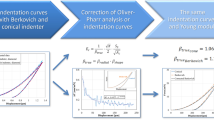Abstract
In this paper, the nanoindentation simulation on the two models of neat polyethylene (PE) and the polyethylene incorporated with 25wt% POSS (POSS-PE) is performed to reveal the reinforcing mechanism of the mechanical properties. The influence of the indenter shapes on nanoindentation is researched by using three different shapes of diamond indenters (cube-corner indenter, cylindrical indenter with spherical tip and cylindrical indenter with flat tip). The molecular mechanics method is adopted to eliminate the temperature effects. Under different indenters, the load-displacement responses, hardnesses (indentation hardness and Martens hardness) and Young’s moduli of PE and POSS-PE are obtained. Compared with PE, all the mechanical properties are improved dramatically. Then, we analyze the source of loading drop phenomena and the enhancement mechanism of POSS. Furthermore, the result shows that the different shapes of indenters cause a large impact on indentation hardness, but a little impact on Martens hardness. And Young’s modulus of the flat indenter is much larger than that of cube-corner indenter and spherical indenter.
Similar content being viewed by others
References
Peng, Y. and Mccabe, C., Molecular simulation and theoretical modeling of polyhedraloligomeric silsesquioxanes. Molecular Physics, 2007, 105: 261–272.
Tsuchida, A. and Bolln, C. et al., Ethene and propene copolymers containing silsesquioxane side groups. Macromolecules, 1997, 30: 2818–2824.
Li, G.Z. and Wang, L.C. et al., Polyhedral oligomeric silsesquioxane (POSS) polymers and copolymers: A review. Journal of Inorganic and Organometallic Polymers, 2001, 11: 123–154.
Zeng, F.L., Sun, Y., Zhou, Y. and Li, J., Molecular mechanics simulation on the nanoindentation on POSS nanocomposite. Proceedings of SPIE, 2007, 6423: 642322.
Dodiuk, H. and Kenig, S. et al., Nanotailoring of epoxy adhesives by polyhedral-oligomeric-sil-sesquioxanes (POSS). International Journal of Adhesion & Adhesives, 2005, 25: 211–218.
Pielichowski, K. and Njuguna, J., Polyhedral oligomeric silsesquioxane (POSS) containing nanohybrid polymers. Advances in Polymer Science, 2006, 201: 225–296.
Zeng, F.L., Sun, Y., Zhou, Y. and Li, Q.K., A molecular dynamics simulation study to investigate the elastic properties of PVDF and POSS nanocomposites. Modelling and Simulation in Materials Science and Engineering, 2011, 19: 025005.
Jeng, Y.R., Tsai, P.C. and Liu, Y.H., Adsorbed multilayer effects on the mechanical properties in nanometer indentation depth. Materials Research Bulletin, 2009, 44: 1995–1999.
Wahab, M.A., Mya, K.Y. and He, C.B., Synthesis, morphology, and properties of hydroxyl terminated-POSS/polyimide low-k nanocomposite films. Journal of Polymer Science: Part A: Polymer Chemistry, 2008, 46: 5887–5896.
Zeng, F.L. and Sun, Y., Quasicontinuum simulation of nanoindentation of nickel film. Acta Mechanica Solida Sinica, 2006, 19(4): 283–288.
Lee, H.J., Hur, S. and Han, S.W. et al., The mechanical properties of thin polymer film for nanoimprinting lithography by nanoindentation. Nanotechnology, 2003, 2: 546–549.
Sun, H., COMPASS: An ab initio force-field optimized for condensed-phase applications-overview with details on alkane and benzene compound. Journal of Physical Chemistry B, 1998, 102: 7338–7364.
Lu, Y.C. and Shinozaki, D.M., Characterization and modeling of large displacement micro-/nanoindentation of polymeric solids. Journal of Engineering Materials and Technology-Transactions of the Asme, 2008, 130(4): 041001.1–041001.7.
Csikor, F.F., Motz, C. and Weygand, D. et al., Dislocation avalanches, strain bursts, and the problem of plastic forming at the micrometer scale. Science, 2007, 312(5848): 251–254.
Feng, G. and Ngan, A.H.W., Creep and strain burst in indium and aluminium during nanoindentation. Scripta Materialia, 2001, 45: 971–976.
Oliver, W.C. and Pharr, G.M., An improved technique for determining hardness and elastic-modulus using load and displacement sensing indentation experiments. Journal of Materials Research, 1992, 7(6): 1564–1583.
Oliver, W.C. and Pharr, G.M., Measurement of hardness and elastic modulus by instrumented indentation: Advances in understanding and refinements to methodology. Journal of Materials Research, 2004, 19(1): 3–20.
Shahdad, S.A. and McCab, J.F. et al., Hardness measured with traditional Vickers and Martens hardness methods. Dental Materials, 2007, 23: 1079–1085.
Xue, Z., Huang, Y., Hwang, K.C. and Li, M., The influence of indenter tip radius on the micro-indentation hardness. Journal of Engineering Materials and Technology, 2002, 124(3): 371–379.
Yashiro, K., Furuta, A. and Tomita, Y., Nanoindentation on crystal/amorphous polyethylene: Molecular dynamics study. Computational Materials Science, 2006, 38(1): 136–143.
Bischel, M.S. and Vanlandingham, M.R. et al., On the use of nanoscale indentation with the AFM in the identification of phases in blends of linear low density polyethylene and high density polyethylene. Journal of Materials Science, 2000, 35(1): 221–228.
Misra, R., Fu, B.X. and Morgan, S.E., Surface energetics, dispersion, and nanotribomechanical behavior of POSS/PP hybrid nanocomposites. Journal of Polymer Science Part B: Polymer Physics, 2007, 45(17): 2441–2455.
Author information
Authors and Affiliations
Corresponding author
Additional information
Project supported by the National Natural Science Foundation of China (No. 10972066), the Doctoral Program Foundation of Institutions of Higher Education of China (No. 20070213054), the Natural Science Foundation of the Heilongjiang Province of China (A2007-10) and the Fundamental Research Funds for the Central Universities (No. HIT. NSRIF. 2010070).
Rights and permissions
About this article
Cite this article
Hu, E., Sun, Y., Zeng, F. et al. Nanoindentation Simulation of PE/POSS under Different Shapes of Indenters. Acta Mech. Solida Sin. 24, 365–372 (2011). https://doi.org/10.1016/S0894-9166(11)60037-2
Received:
Revised:
Published:
Issue Date:
DOI: https://doi.org/10.1016/S0894-9166(11)60037-2




